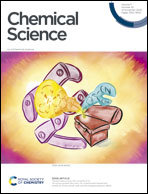A hierarchical assembly strategy for near-infrared photothermal conversion: unconventional heterogeneous metalla[2]catenanes†‡
Abstract
Herein, we report a hierarchical assembly strategy for constructing heterogeneous half-sandwich organometallic D–A (D = π-donor, A = π-acceptor) interlocked structures, and their application in near-infrared (NIR) photothermal conversion. Thienothiophene and diketopyrrolopyrrole groups were selected as the D and A units, leading to two homogeneous metalla[2]catenanes with D–D–D–D and A–A–A–A stacks, respectively. By the ordered secondary assembly of homogeneous metalla[2]catenanes, two unprecedented heterogeneous D–A metalla[2]catenanes comprising an unusual mixed D–A–D–D and unconventional D–A–A–A stacks were realized by the combination of multiple noncovalent interactions, as all demonstrated by a detailed X-ray crystallographic study. Benefiting from the mixed D–A stacking modes, NIR absorption of heterogeneous D–A metalla[2]catenanes is significantly enhanced in contrast to homogeneous metalla[2]catenanes. Thanks to the enhanced NIR absorption and the fluorescence quenching effect from half-sandwich organometallic fragments, heterogeneous D–A metalla[2]catenanes displayed high-performance NIR photothermal conversion properties (η = 27.3%).
![Graphical abstract: A hierarchical assembly strategy for near-infrared photothermal conversion: unconventional heterogeneous metalla[2]catenanes](/en/Image/Get?imageInfo.ImageType=GA&imageInfo.ImageIdentifier.ManuscriptID=D0SC04523C&imageInfo.ImageIdentifier.Year=2020)


 Please wait while we load your content...
Please wait while we load your content...